
![]() See Bahasa Indonesia translation/versi Bahasa Indonesia
See Bahasa Indonesia translation/versi Bahasa Indonesia
90th Edition: May 2021.
Key Points
- Australian feeder steer prices remain above $4 per kg live.
- NACC, a major Aussie live exporter enters administration.
- Vietnam restarts live imports in May.
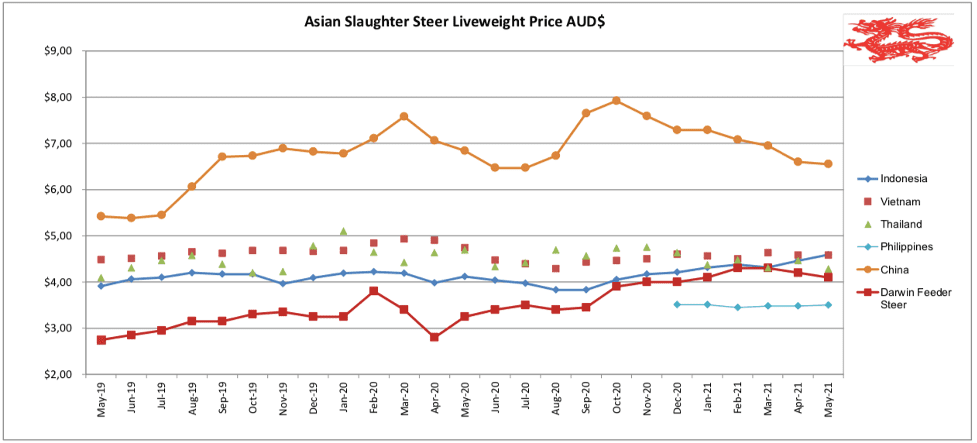
Indonesia : Slaughter Steers AUD $4.59/kg live weight (Rp11,100 = $1AUD)
Slaughter steer prices have firmed a little although the market has a very wide range of pricing levels at the end of May. The asking price spread stretches from Rp49,500 to Rp55,000 per kg live weight as demand and supply factors experience even more volatility than usual. Considering the many competing forces, I have fixed the indicator price for May at Rp51,000. Supply is certainly restricted by low feedlot numbers while retail prices have firmed to rates even higher than those seen during Ramadan/Lebaran. Behind all these figures are very low volumes for both live animal and fresh meat sales so it is not surprising that prices are all over the place.
Qurban is the Muslim festival of sacrifice during which cattle, sheep and goats are slaughtered for distribution to the poor. This year the festival will take place on the 20th of July so what normally happens is that local cattle, sheep and goats identified for the festival are retained for several months prior to the celebration date in order to have adequate numbers of stock on hand and also to take advantage of the usual 10-20% price premium for this special event. As a result, the supply of locally bred stock dries up for several months prior to the event adding another factor to the market price equation. Local cattle prices have recently been below the price of imported cattle but the Qurban demand has brought their rates up to equal to imported cattle with an expectation that they will continue to climb higher than imports as the festival approaches.
The period between the festivals of Lebaran and Qurban is traditionally favoured for weddings and other important celebrations leading to an increase in the demand of food stuffs for these events including the most favoured meat which is of course beef. Just another force driving demand and pushing retail prices higher.
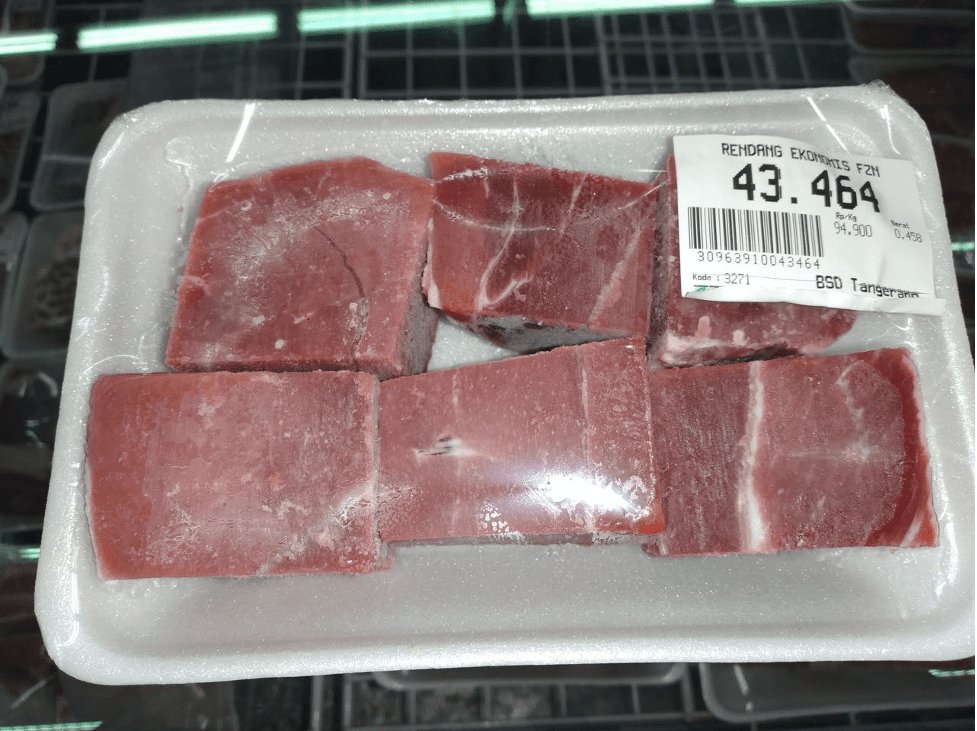
Indian buffalo beef prices have increased during May with this supermarket selling for Rp94,900 per kg well above the government target price of Rp80,000.
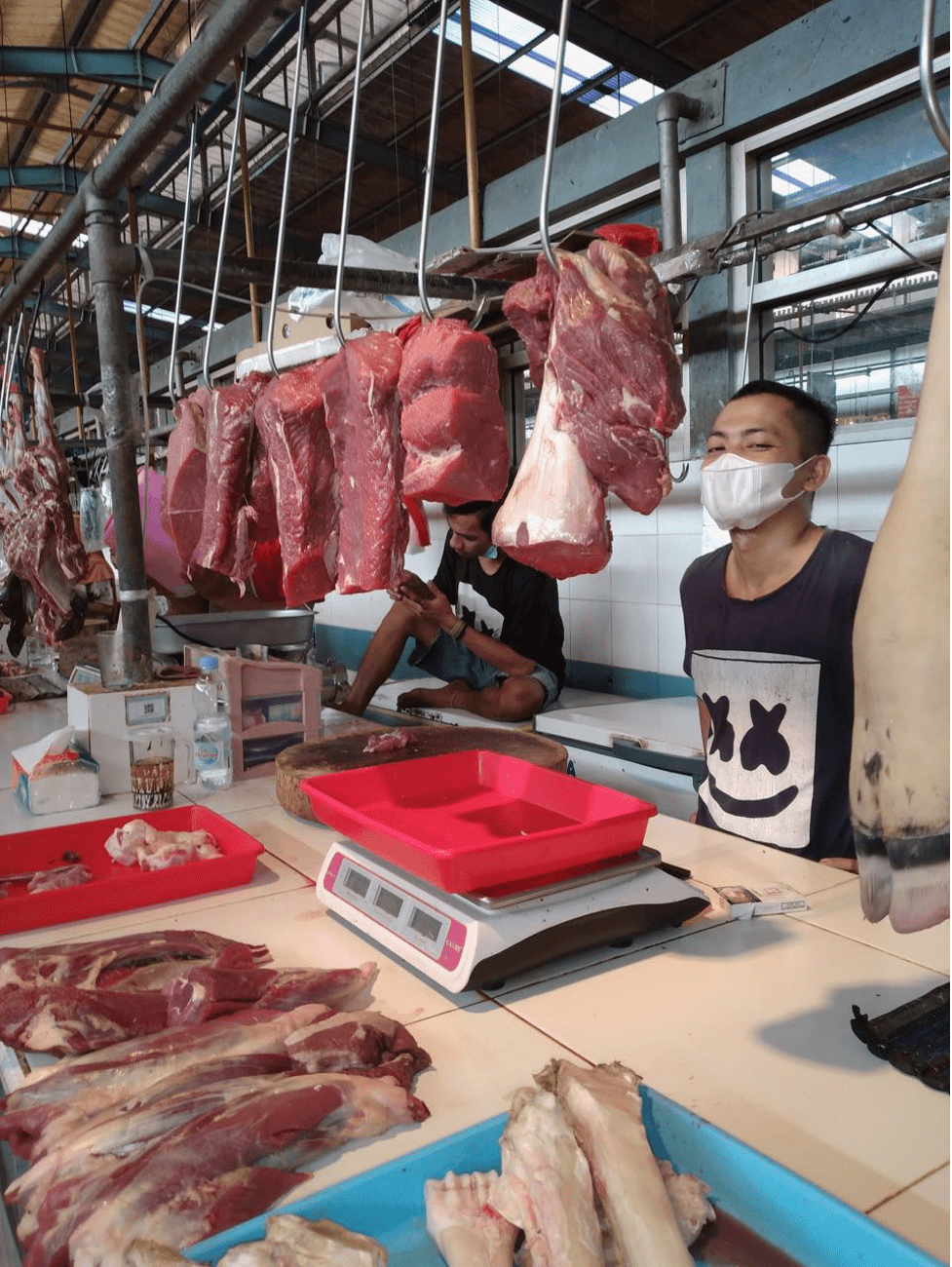
The Pasar Modern wet market rates have risen to Rp160,000 for knuckle for the first time.
Another new factor which I have only just learned about is the rapidly rising feedlot feed commodity prices. The supply of these products is being modified by a range of factors as food processing evolves. The cost of the feedlot ration is estimated to have increased by about 10%. One example is the high starch waste from the processing of cassava which is called onggok. This has been a great source of cheap energy for the feedlot industry but as industrial extraction processes have improved over time, less of the starch is left in the waste and more of it ends up in the primary product which is tapioca for human consumption. Another example is copra meal which is the waste left over after coconuts are processed to extract the copra for human consumption. This has always been a manual process requiring farmers to spend long hours in the manual extraction process. Just like everywhere else in the world, farmers are allocating their time to more productive tasks so time consuming copra meal supplies are declining sharply. These forces are no doubt happening across the broad range of agricultural “waste” products which are the backbone of the feedlot industry so the trend of reduced supply and higher prices is likely to continue.
For the first time in my memory the retail price of beef in the wet market has risen dramatically after Lebaran. My Jakarta reporter advises that the price for knuckle in the BSD City wet market of Pasar Modern has risen from Rp145,000 per kg during Lebaran to Rp160,000 per kg at the end of May. The knuckle price in the supermarket has only risen from its Lebaran discount (142k) to its normal rate of Rp158,000 per kg. Indian buffalo beef however has also risen from Rp80,000 during Lebaran to Rp94,900 per kg at the end of May. Indian buffalo imports have been in the press during May with the Indonesian government saying that imports have been suspended pending a review of the risk of importation of Covid contaminated product from India while the Indian press has published articles denying that there is any restriction to their frozen buffalo exports.
The first containers of Brazilian beef to arrive for some time have landed in the Jakarta docks during May with more on the way. The first shipments consist of 420 tons representing the initial delivery of a total 2021 quota of 20,000 tons.
Other sources of processed beef imports include Australia (main source), USA, New Zealand and Spain.
Australian processed beef imports are being delivered at a reduced rate with only 27,206 tons delivered during the first 4 months of the year from an annual quota of 187,478 tons.
Total live cattle imports for April were 39,659 after 35,680 in March which is likely to further reduce the total numbers on feed in Indonesia and contribute to reducing fresh beef supplies in coming months. These numbers represent a year on year reduction in imports of 32%.
Indonesian importers purchased 429 live buffalo through the port of Darwin during May while another 223 were exported to Brunei.
With reduced demand from Indonesia and Vietnam, exporters are actively searching for alternative import destinations. During April shipments were also exported to Malaysia (1893 head), Brunei (4128) and the Philippines (1390).
On the 1st of June, Beef Central reported that North Australian Cattle Company, once one of Australia’s largest live cattle exporters, had been placed into voluntary administration, with debits owed to trade creditors of approximately $3.6 million. This is another strong indicator of the unbalanced nature of the trade at the present time where producers are receiving record returns while exporters, importers, processors and retail customers are struggling.
The course of the pandemic in Indonesia varies depending on the location with Bali making great progress with its vaccination programme while the rest of the country is bracing for a potential spike in cases after a large number of residents return from their (banned) visits to relatives during Lebaran.
Darwin feeder steer prices have eased slightly from AUD$4.20 per kg live in April to $4.10 in May. Townsville slaughter steer rates also backed off a little during May to around $3.65 from $3.80 in April.
Vietnam: Slaughter Steers AUD $4.58/kg (VND17,900 to $1AUD)
Slaughter rates continue to hold steady at their recent levels during May with the indicator rate for steers still at Dong82,000 per kg live weight. After zero imports in March, only 3,713 head were imported during April (one shipment). Year on year until the end of April, the live exports to Vietnam were down by 59%. By ringing around the main ports it appears that roughly 19,000 have been exported to Vietnam during May. Unfortunately, our only national statistics come through government agencies and then on to the MLA so the lag phase between activity and reporting is extremely slow. There is nothing secret about these figures (as gross monthly numbers) so there is no reason why government agencies should be so slow in providing this information as we know the data is collected and centrally recorded at the time when each ship leaves the country. The antiquated administrative processes that regulate live exports generate very high costs which are then charged back to exporters. This last century paper trail is no doubt a major part of the problem. An electronic management system would allow this data to be available in real time and cut costs to everyone.
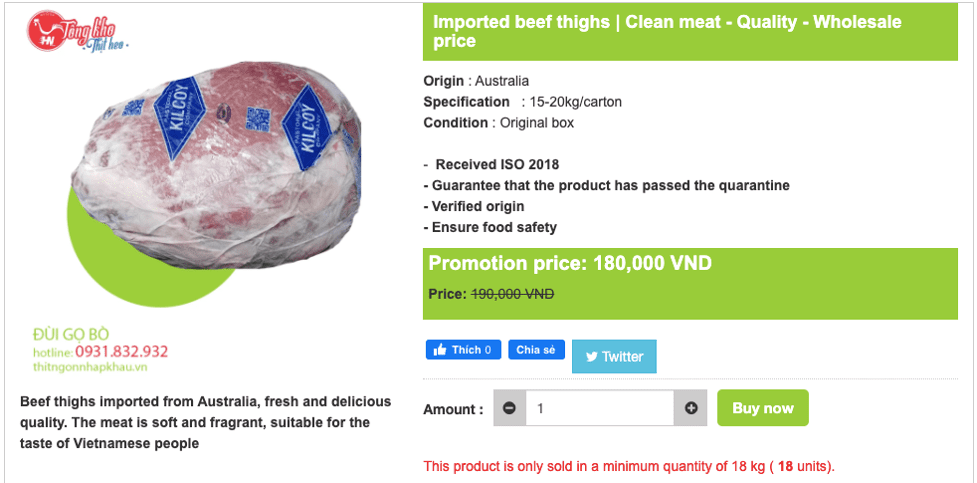
On-line advertising from the “Imported Delicious Meat Co.” offering Kilkoy knuckle in carton lots with a large discount @ Dong180,000 per kg compared to the supermarket price of Dong 330,000 per kg.
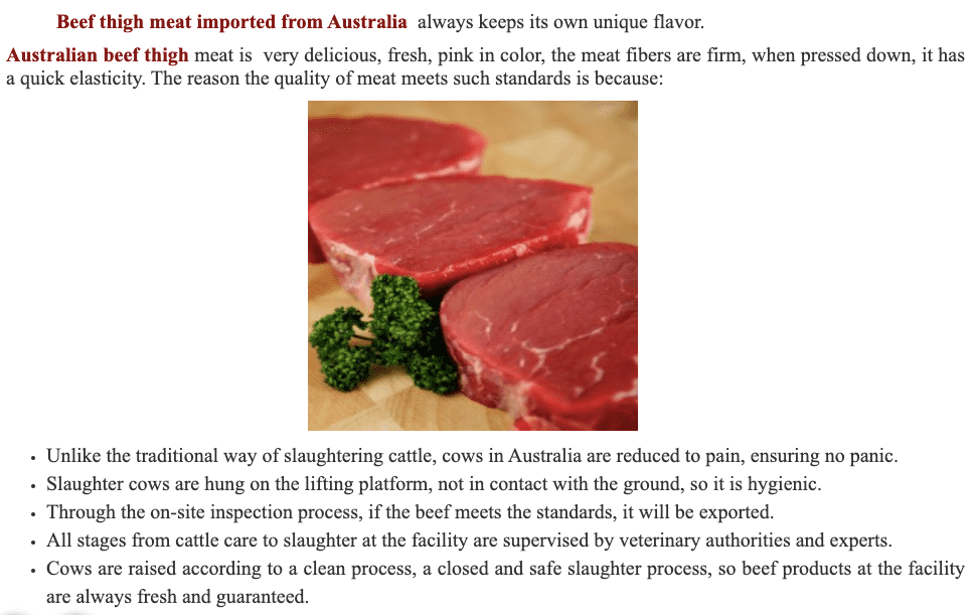
More advertising of the benefits of Australian beef from the Imported Delicious Meat Co.
Lumpy skin disease (LSD) continues to be a problem in a number of areas of Vietnam. The disease was first identified near the Chinese border in 2020 and has spread to a large number of districts since although the current status does not appear on the web. Vaccination programs have commenced with at least 50,000 doses already administered and many more to come. LSD is currently endemic in Africa, parts of the Middle East and Turkey. Since 2015, the disease has spread to most of the Balkan countries, the Caucasus and the Russian Federation, where the disease continues to spread. Since 2019, several new outbreaks of LSD have been reported including Bangladesh, India, China, Chinese Taipei, Bhutan, Hong Kong, Nepal, Sri Lanka, Myanmar and most recently Thailand.
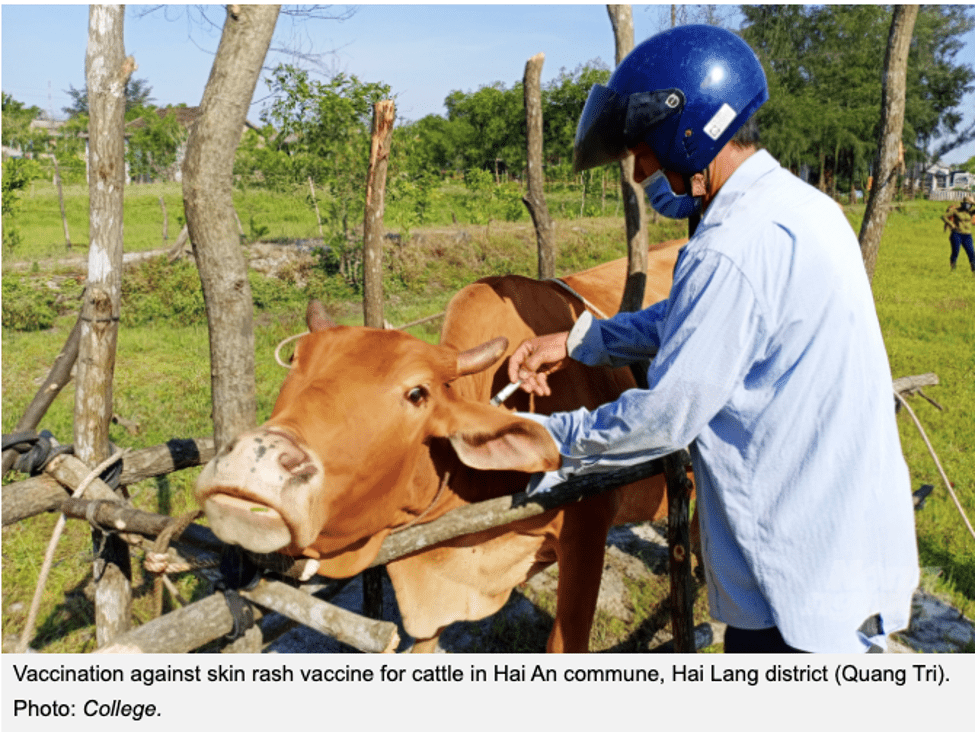
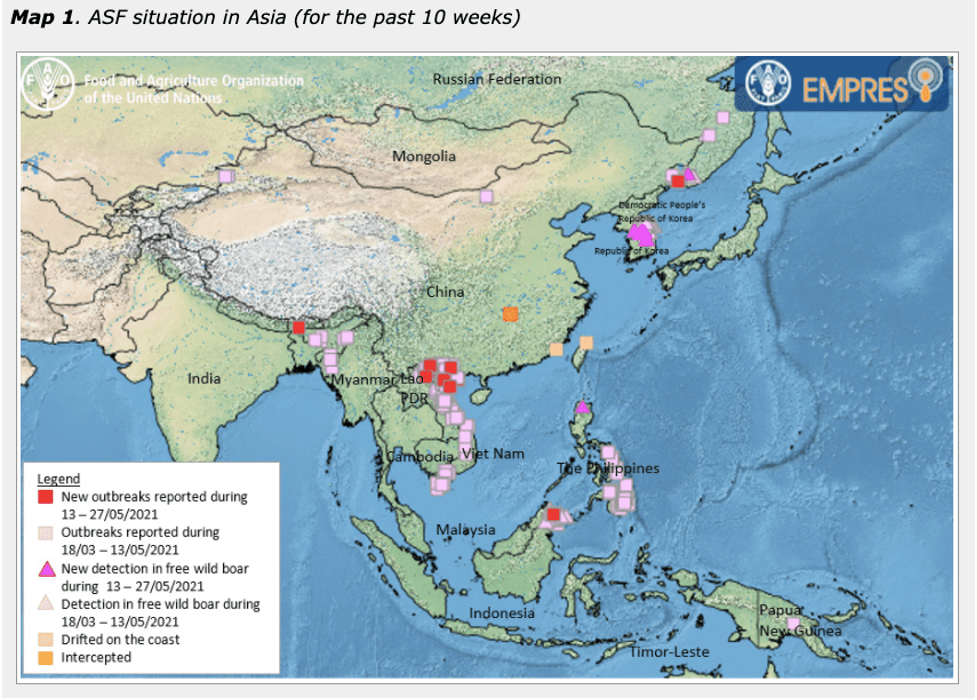
FAO situation map for African Swine Fever (ASF) as at the 27th May 2021.
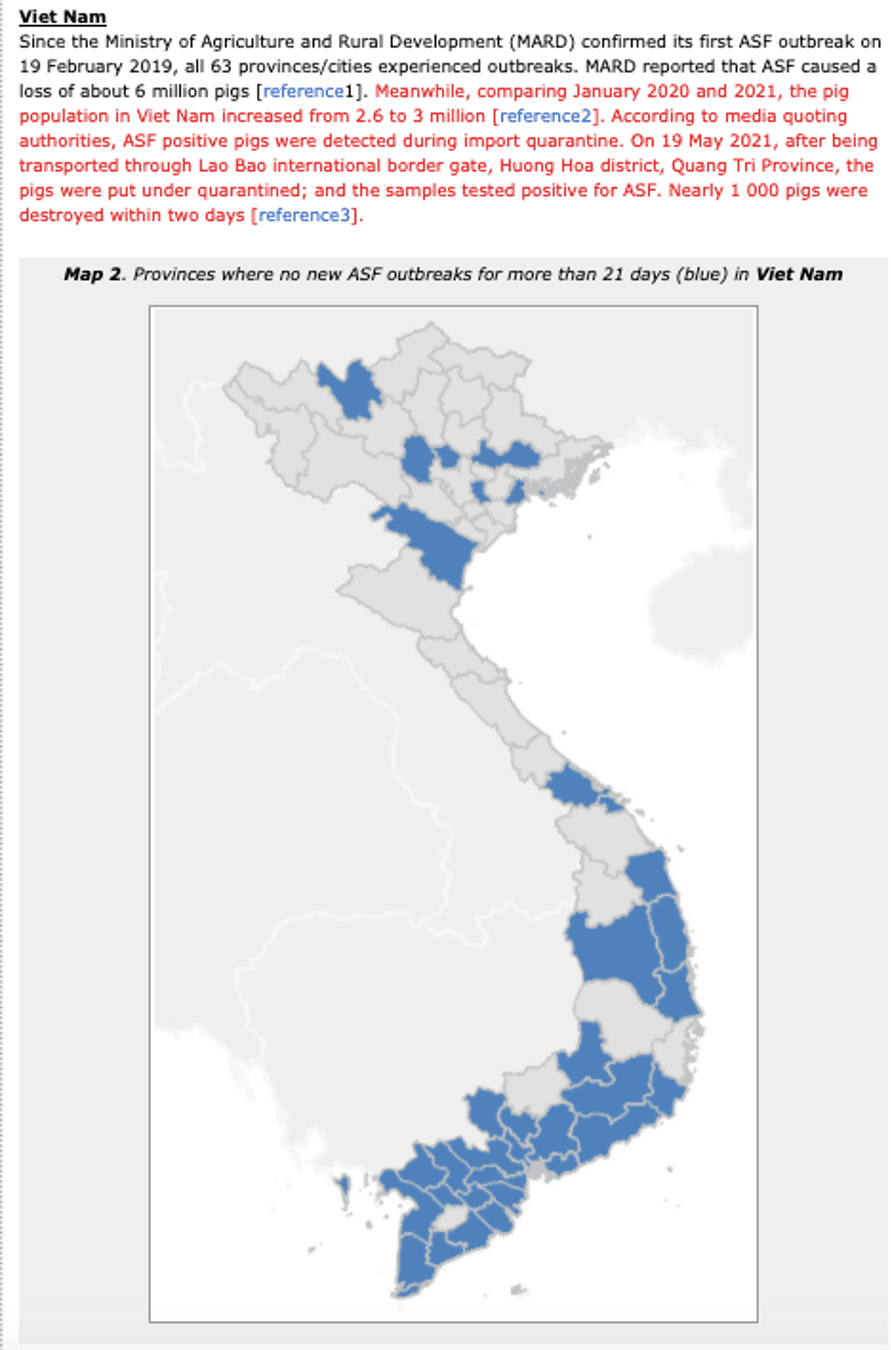
The notes and map above from the official FAO site at the end of May 2021 show how Vietnam is making real progress with its fight against the ASF virus.
China: Slaughter Cattle AUD $6.55 / kg live weight (RMB 4.95 = AUD$)
Chinese slaughter cattle prices continue their declining trend with a further fall from Y33.2 in April to Y32.4 in May. This translates to a new indicator rate of AUD$6.55 when a stronger Yuan exchange rate is applied. Falls in prices are similar in both Beijing and Shanghai. The puzzling trend of falling or static retail beef and pork prices continues. China reports a surge in GDP growth and domestic consumption as their post Covid recovery gathers momentum. Virtually all reports of beef exports around the world indicate supplies are tight and prices are rising from all sources. And China is the world’s largest importer of beef by a wide margin. So why is it that the prices of these key consumer items have been steadily declining since October 2020?
Philippines: Slaughter Cattle AUD $3.50 / kg (Peso 37.1 to AUD$1)
No change in slaughter rates once again this month. I am getting mixed signals from my sources with some reporting that certain areas are slowly emerging from the pandemic lockdown while others report that the situation is getting markedly worse. Covid vaccinations rates are very low with many communities remaining under various forms of lockdown.
There has been only 1 shipment of cattle from Australia to the Philippines until the end of April. In 2019, a total of 14,500 were imported while in 2020 the number rose to 17,500.
Thailand: Slaughter Steers AUD $4.28 / kg (Baht 24.3 to $1AUD)
Slaughter cattle prices backed off during May as a result of severe new movement restrictions as a result of the discovery of Lumpy Skin Disease in the country for the first time. About 7,200 head have been affected across 35 provinces. Authorities have locked down the infected areas as best they can and commenced a vaccination program in the hope of preventing it from spreading further through the domestic herd.
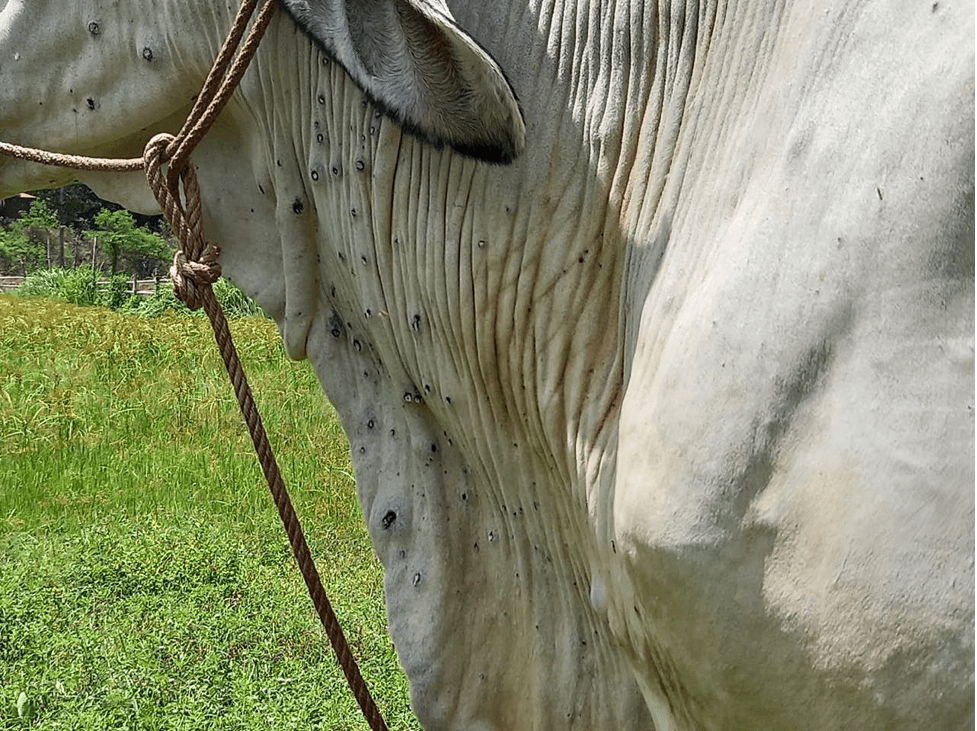
A Thai Bos indicus animal with Lumpy Skin Disease.
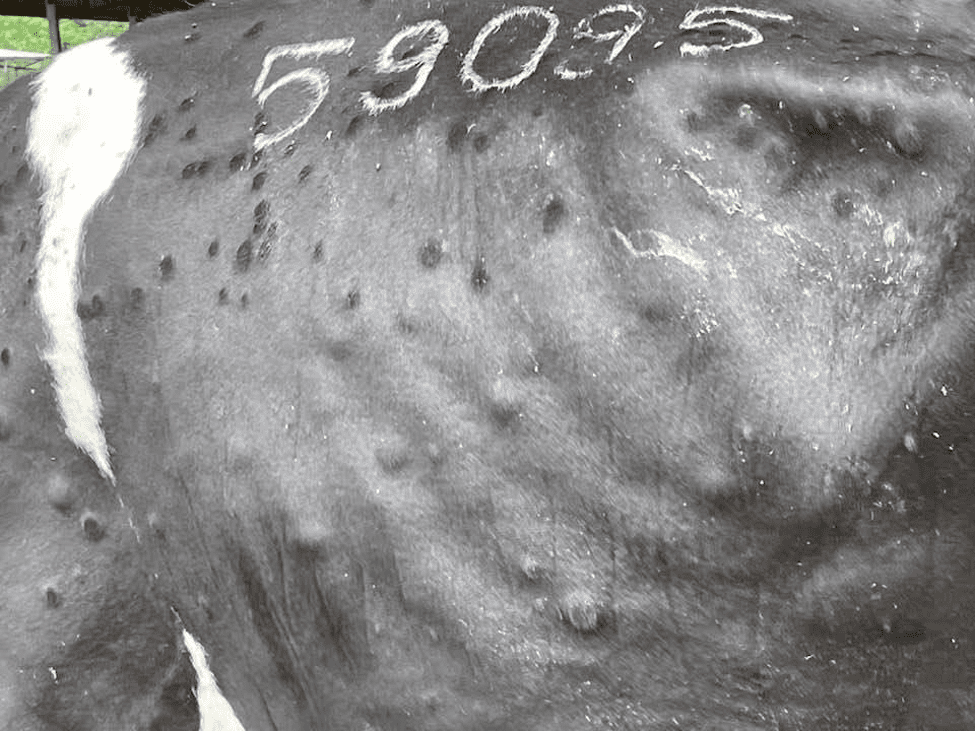
Photo of a Thai dairy cow with Lumpy Skin Disease. Fortunately the Thai authorities were able to source vaccine relatively quickly.
The world of beef feels like a very tightly interconnected community
- Prices for cattle in Brazil (the world’s largest exporter) have doubled in the last 12 months due to reduced supply of slaughter cattle and high demand especially from China.
- High retail prices (up 66% in one year) in Argentina (number 4 exporter) have led the government to halt exports. Prices have risen world-wide. Argentine producers responded by stopping sales to abattoirs collapsing supplies to Argentine consumers. The dispute is ongoing.
- Some of the abattoirs in Argentina are owned by the large Brazilian processors. 70% of all Argentine beef exports go to China.
- The booming demand from China, the world’s largest importer, is straining world supply.
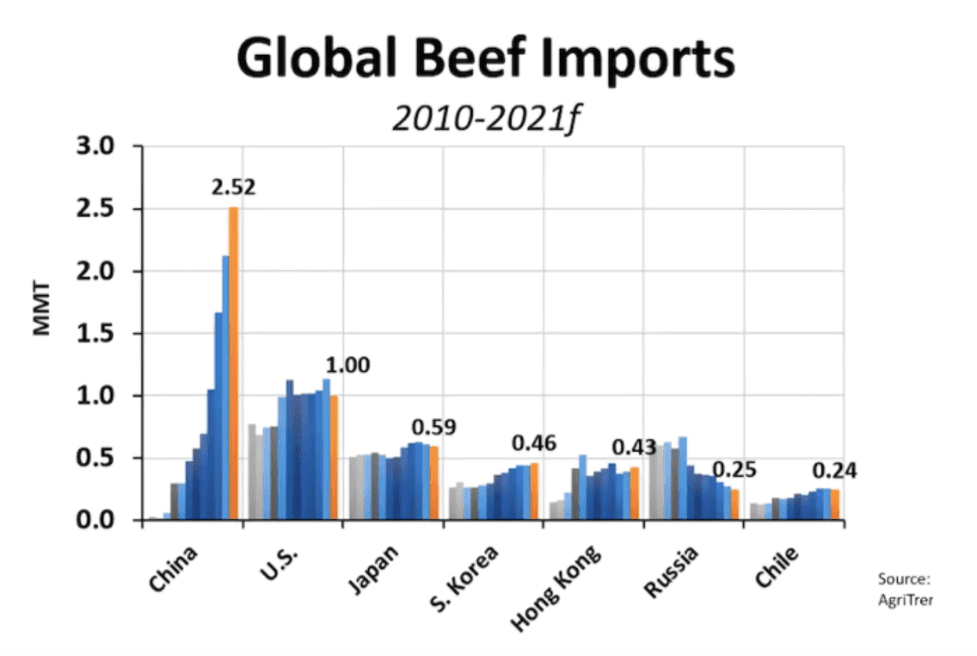
The orange lines above represent the beef import forecast for 2021 in millions of tons.
- The USA is experiencing serious drought conditions reducing grain production and supplies of finished cattle. World grain prices are on the rise.
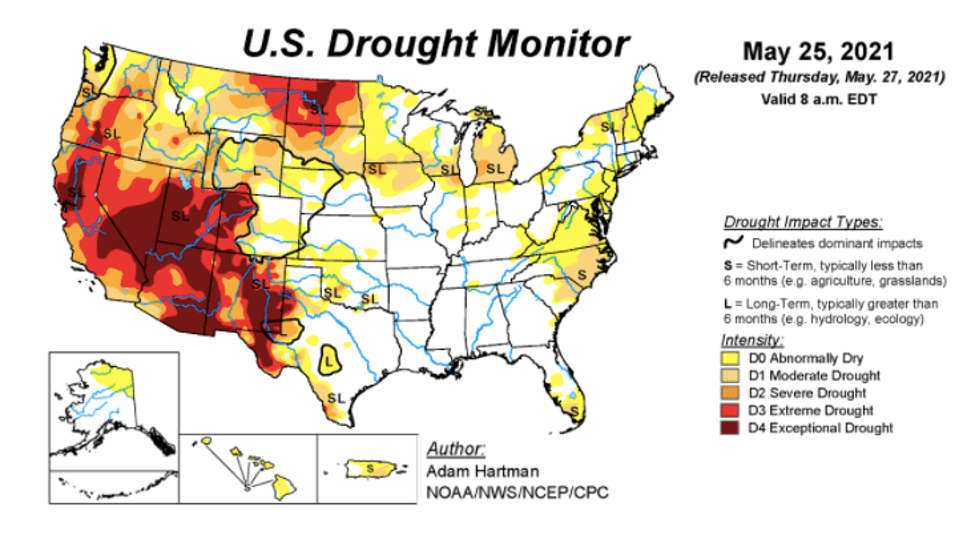
- China punishes Australia (number 2 global exporter) by banning imports from selected abattoirs.
- Australian supply is severely restricted due to herd rebuilding following the drought/floods/fires resulting in record high prices.
- India (number 3 meat exporter) is experiencing production and export problems as a result of the impact of the Covid 19 pandemic.
- Russian hackers interrupt operations of the Brazilian owned JBS, the world’s largest beef processing company. This disruption was large enough to alter short term world supply and cause a spike in prices
- A pig disease in China kills 25% of the world’s pigs resulting in a massive protein shortage. Imported beef from around the globe is being used to partly replace this red meat protein deficit.
- A mix of Covid 19 and Lumpy Skin Disease has halted the normal trade movements of live cattle across SE Asia and into China.
- Covid 19 has also caused serious disruption to the world shipping and container freight trade resulting in increased delivery times and freight costs for beef, and everything else, across the globe.
- The net impact of all these factors appears to be reduced supplies and higher prices for beef in the short to medium term.
May 2021 prices
These figures are converted to AUD$ from their respective currencies which are changing every day so the actual prices here are corrupted slightly by constant foreign exchange fluctuations. The AUD$ figures presented below should be regarded as reliable trends rather than exact individual prices. Where possible the meat cut used for pricing in the wet and supermarket is Knuckle / Round.
| Location | Date | Wet Market
AUD$/kg |
Super market
$/kg |
Broiler chicken
$/kg |
Live Steer
Slaughter Wt AUD$/kg |
| Indonesia | Dec 20 | 12.15 | 14.77 B7.48 | 3.55 | 4.21 |
| Rp10,800 | Jan 21 | 12.04 | 14.63 B7.40 | 3.52 | 4.31 |
| Rp10,970 | Feb 21 | 11.85 | 11.80 B8.66 | 3.56 | 4.38 |
| Rp11,100 | March 21 | 12.16 | 14.23 B8.09 | 3.60 | 4.32 |
| Rp11,200 | April 21 | 12.95 | 12.67 B7.14 | 4.02 | 4.46 |
| Rp11,100 | May 21 | 14.41 | 14.23 B8.55 | 3.60 | 4.59 |
| Philippines | Dec 20 | 15.89 | 16.16 | 4.52 | 6.99 |
| P37.0 | Jan 21 | 13.78 | 14.59 | 4.83 | 3.51 |
| P37.7 | Feb 21 | 13.53 | 14.32 | 4.24 | 3.45 |
| P37.4 | March 21 | 13.64 | 14.44 | 4.68 | 3.48 |
| P37.3 | April 21 | 13.67 | 14.48 | 4.42 | 3.48 |
| P37.1 | May 21 | 13.75 | 14.56 | 4.72 | 3.50 |
| Thailand | Dec 20 | 10.13 | NA | 3.08 | 4.63 |
| THB23.1 | Jan 21 | 9.96 | NA | 3.03 | 4.37 |
| THB23.48 | Feb 21 | 9.80 | NA | 2.98 | 4.47 |
| THB24.7 | March 21 | 9.70 | NA | 2.95 | 4.30 |
| THB 24.0 | April 21 | 9.58 | NA | 2.92 | 4.46 |
| THB 24.3 | May 21 | 9.47 | NA | 2.88 | 4.28 |
| Vietnam | Dec 20 | 17.82 | 18.97 | 4.42 | 4.60 |
| D17,770 | Jan 21 | 17.45 | 15.87 | 4.83 | 4.56 |
| D18,020 | Feb 21 | 17.20 | 17.43 | 4.77 | 4.50 |
| D17,700 | March 21 | 17.51 | 15.97 | 4.52 | 4.63 |
| D17,900 | April 21 | 17.32 | 17.54 | 4.47 | 4.58 |
| D17,900 | May 21 | 17.32 | 18.43 | 5.25 | 4.58 |
| China Beijing | Dec 20 | 18.22 | 21.46 | 3.85 | 7.29 |
| Y4.98 | Jan 21 | 18.47 | 22.49 | 3.82 | 7.39 |
| Y5.04 | Feb 21 | 17.46 | 21.43 | 3.69 | 7.18 |
| Y5.03 | March 21 | 16.30 | 19.43 | 3.62 | 6.99 |
| Y5.03 | April 21 | 17.10 | 18.29 | 3.54 | 6.52 |
| Y4.95 | May 21 | 16.57 | 18.59 | 3.60 | 6.46 |
| Shanghai | Dec 20 | 19.43 | 23.89 | 3.60 | 7.29 |
| Pork per kg | Jan 21 | 20.48 | 24.50 | 3.57 | 7.19 |
| Beijing Y48 | Feb 21 | 19.44 | 24.21 | 3.53 | 6.98 |
| ShanghaiY46 | March 21 | 18.29 | 23.46 | 3.54 | 6.91 |
| April 21 | 17.89 | 22.66 | 3.54 | 6.68 | |
| May 21 | 17.78 | 22.22 | 3.60 | 6.63 | |
| Darwin Feeder Steer | June 19
$2.90 |
July 19
$3.00 |
August 19
$3.15 |
Sept 19
$3.15 |
October 19
$3.30 |
| Nov 19
$3.35 |
Dec 19
$3.25 |
January 2020
$3.25 |
Feb 2020 $3.80 | March 2020
$3.40 |
|
| April 20
$2.80 |
May 20
$3.25 |
June 2020
$3.40 |
July 2020
$3.50 |
August 2020
$3.40 |
|
| Sept 2020
$3.45 |
October 2020
$3.90 |
Nov 2020
$4.00 |
Dec 2020
$4.00 |
Jan 21
$4.10 |
|
| Feb 21
$4.30 |
March 21
$4.30 |
April 21
$4.20 |
May 21
$4.10 |



These prices that are quoted for livestock to Asian countries are FOB or CIF prices.